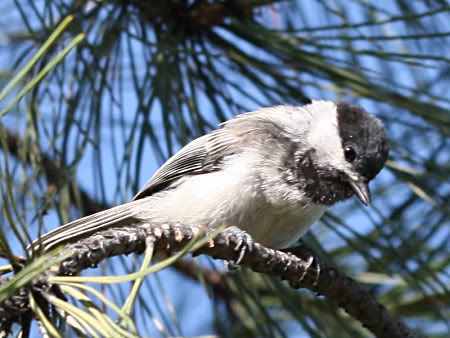
I think chickadees are supposed to have some yellow on the side belly. Can't see any hint of yellow. That part might be a bit over-exposed.
I have wanted a chickadee photo ever so much for a long time, but have never been able to get close enough to them. I can hear them all the time. I love the chickadee's little polite two-note song. They are usually too far away, high up in the tree, and/or they are so tiny I usually can't see them.
My companion went chasing after the chickadee with the tele and got a picture! I was so excited. Except, I didn't get to take it.
Chickadees don't migrate. How they survive the brutal cold is interesting.
Chickadees Are Cold Weather Machines
Google heterothermy
How Wild Birds Stay Warm in the Winter
"Thermogenesis is a fancy name for shivering. You can't really see it, but all birds shiver in the cold of winter."
"At night, birds such as the little chickadee take shivering, or lack of one step further. To conserve heat and energy, chickadees can lower their body temperature by interrupting their shivering. These periods of inactivity allow the bird's body temperature to slowly cool, until it drops about 10 or 12 degrees. At this point, the bird enters a state of unconsciousness called torpor. Respiration and heart rate will also drop during this period."
cornell
"In most of North America, the song is a simple, pure 2 or 3-note whistled fee-bee or hey, sweetie."
enature
"a clear, whistled fee-bee, the second note lower and often doubled."

No comments:
Post a Comment